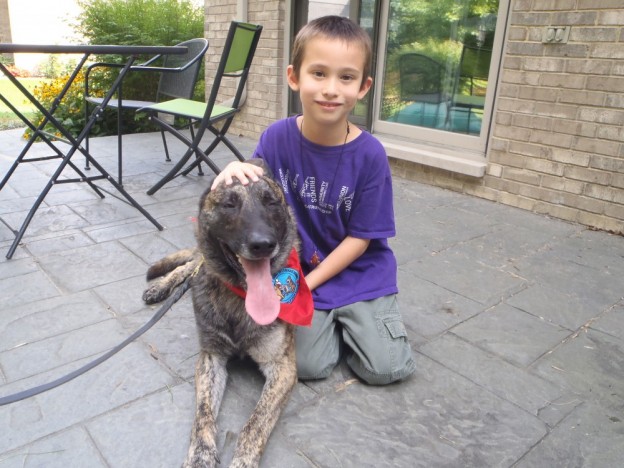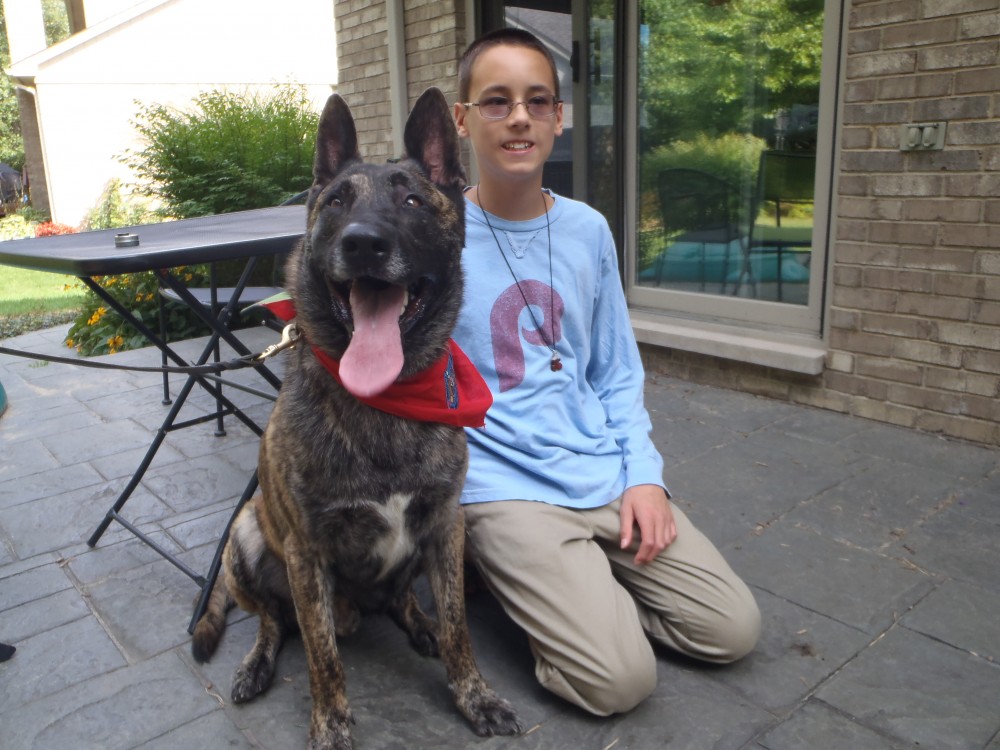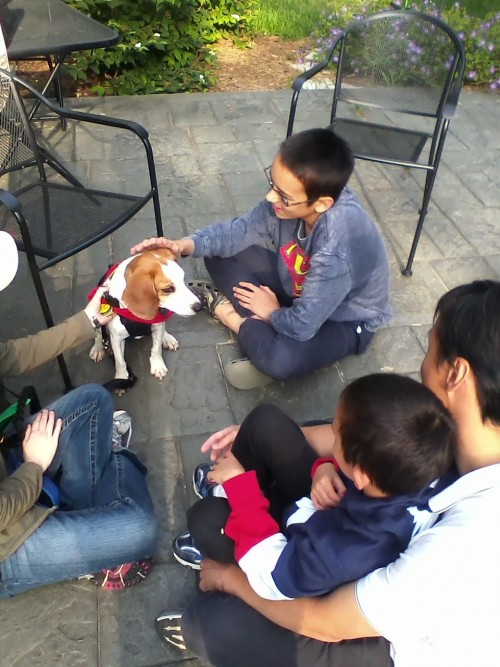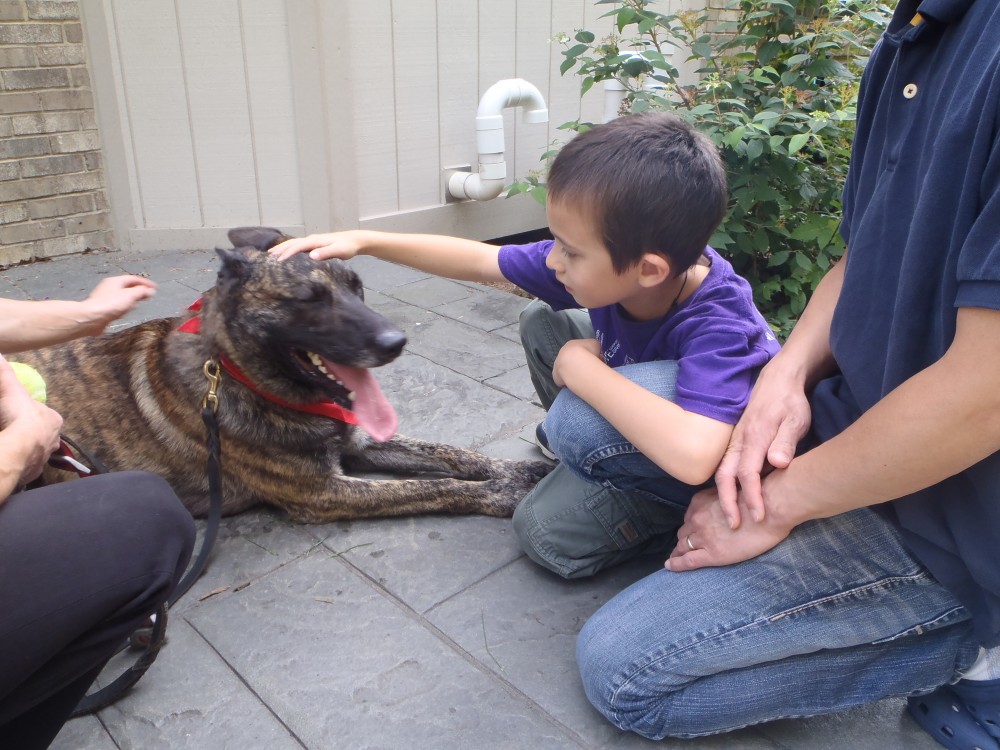
Resources  I mailed in the form on a Thursday, and on Monday morning, I started receiving dozens of phone calls and emails from local volunteers who wanted to work with us. It was difficult to sort through all of the contacts, and I wasn’t able to respond to everyone. I scheduled appointments with an experienced Beagle that had received additional training beyond the therapy dog certification, and a Dutch Shepherd whose handler is a veterinarian. The veterinarian offered to arrange additional visits with a friend who teaches seminars on bite prevention.
I mailed in the form on a Thursday, and on Monday morning, I started receiving dozens of phone calls and emails from local volunteers who wanted to work with us. It was difficult to sort through all of the contacts, and I wasn’t able to respond to everyone. I scheduled appointments with an experienced Beagle that had received additional training beyond the therapy dog certification, and a Dutch Shepherd whose handler is a veterinarian. The veterinarian offered to arrange additional visits with a friend who teaches seminars on bite prevention.
 When we were visited by the Beagle, we had the opportunity to give the dog treats in exchange for simple tricks like shaking hands. This was a particularly challenging activity for my older son, who did not want to put his hand anywhere near the dog’s mouth. However, after seeing several tricks, he was able to give the dog a treat and pull his hand away quickly.
When we were visited by the Dutch Shepherd, we played a game of fetch in the backyard. This activity allowed my children to see the fun, playful side of the dog’s personality, which they had never experienced because of their fear. The dog always dropped the ball at our feet, so my son did not have to put his hand near the dog’s mouth at any time. Most home visits last 30 to 60 minutes, depending on the needs of the individual requesting the visit - and that allows plenty of time for play!
When we were visited by the Beagle, we had the opportunity to give the dog treats in exchange for simple tricks like shaking hands. This was a particularly challenging activity for my older son, who did not want to put his hand anywhere near the dog’s mouth. However, after seeing several tricks, he was able to give the dog a treat and pull his hand away quickly.
When we were visited by the Dutch Shepherd, we played a game of fetch in the backyard. This activity allowed my children to see the fun, playful side of the dog’s personality, which they had never experienced because of their fear. The dog always dropped the ball at our feet, so my son did not have to put his hand near the dog’s mouth at any time. Most home visits last 30 to 60 minutes, depending on the needs of the individual requesting the visit - and that allows plenty of time for play!
 Our family is not ready to adopt a dog yet, but the home visits have helped my children understand that dogs can be gentle and fun companions. Therapy dogs also helped my children gain insight about their emotions. My older son told me, “I was scared at first, but then I was happy.”
Some other articles you may be interested in:
Our family is not ready to adopt a dog yet, but the home visits have helped my children understand that dogs can be gentle and fun companions. Therapy dogs also helped my children gain insight about their emotions. My older son told me, “I was scared at first, but then I was happy.”
Some other articles you may be interested in:
How To Arrange A Free Therapy Dog Home Visit
Fact: If you or a family member has a disability, then your family is eligible for home visits from a certified therapy dog and trained handler. Fact: There is no cost for this service, since the dog and the handler are both volunteers. I began inquiring about therapy dogs after both of my children were bitten by strangers’ dogs in separate, unprovoked attacks. In both cases, the dogs’ owners were at fault, we filed police reports and we ended up with two frightened children. Because of the trauma and my older son’s developmental disability, my family was eligible for home visits through Therapy Dogs International (TDI), the world’s largest therapy dog organization.How do I apply for home visits?
I contacted TDI through the website to ask how to apply for home visits. Within 48 hours, I received an email with a home visit request form. The form had to signed by a physician to certify that the person has a medical need for therapy visits, but for privacy reasons the form did not ask for a diagnosis. Getting a physician’s signature was simple for us, because my son’s pediatrician had treated him for the dog bite and knew about his phobia. I mailed in the form on a Thursday, and on Monday morning, I started receiving dozens of phone calls and emails from local volunteers who wanted to work with us. It was difficult to sort through all of the contacts, and I wasn’t able to respond to everyone. I scheduled appointments with an experienced Beagle that had received additional training beyond the therapy dog certification, and a Dutch Shepherd whose handler is a veterinarian. The veterinarian offered to arrange additional visits with a friend who teaches seminars on bite prevention.
I mailed in the form on a Thursday, and on Monday morning, I started receiving dozens of phone calls and emails from local volunteers who wanted to work with us. It was difficult to sort through all of the contacts, and I wasn’t able to respond to everyone. I scheduled appointments with an experienced Beagle that had received additional training beyond the therapy dog certification, and a Dutch Shepherd whose handler is a veterinarian. The veterinarian offered to arrange additional visits with a friend who teaches seminars on bite prevention.
What are the goals of a home visit?
When scheduling a visit, a trainer will ask, “What are your goals during these visits?” I had a list of several goals with an increasing level of difficulty:- to be able to look at a dog without panicking
- to be able to sit near a dog
- to touch a dog
- to play fetch with a dog
- to name parts of the dog’s body
- to identify body parts used for communication
- to identify the difference between a relaxed dog and an aggressive dog
- to verbalize fear or injury
- to learn how to prevent aggression and biting
What happens during a home visit?
Petting the dog and talking to or about the dog are the main activities during a home visit. I asked the handlers to talk about the dog’s training, which was comforting for my children to hear. The dogs had been trained not to react to sudden noises or movements and to remain calm while being petted by multiple people. All therapy dogs are tested to make sure that they are comfortable around men, women and children. Therapy dogs remain on leash and follow commands throughout the visit. When we were visited by the Beagle, we had the opportunity to give the dog treats in exchange for simple tricks like shaking hands. This was a particularly challenging activity for my older son, who did not want to put his hand anywhere near the dog’s mouth. However, after seeing several tricks, he was able to give the dog a treat and pull his hand away quickly.
When we were visited by the Dutch Shepherd, we played a game of fetch in the backyard. This activity allowed my children to see the fun, playful side of the dog’s personality, which they had never experienced because of their fear. The dog always dropped the ball at our feet, so my son did not have to put his hand near the dog’s mouth at any time. Most home visits last 30 to 60 minutes, depending on the needs of the individual requesting the visit - and that allows plenty of time for play!
When we were visited by the Beagle, we had the opportunity to give the dog treats in exchange for simple tricks like shaking hands. This was a particularly challenging activity for my older son, who did not want to put his hand anywhere near the dog’s mouth. However, after seeing several tricks, he was able to give the dog a treat and pull his hand away quickly.
When we were visited by the Dutch Shepherd, we played a game of fetch in the backyard. This activity allowed my children to see the fun, playful side of the dog’s personality, which they had never experienced because of their fear. The dog always dropped the ball at our feet, so my son did not have to put his hand near the dog’s mouth at any time. Most home visits last 30 to 60 minutes, depending on the needs of the individual requesting the visit - and that allows plenty of time for play!
Are the visits helpful?
Considering that my older son started the first home visit being unable to look at a dog without intense fear, he made extraordinary progress in a brief period. Within a few minutes, he was able to sit near the dog; and a few minutes after that, he couldn’t resist petting the dog and saying that the dog’s fur was soft. Similarly, my younger son was reluctant to touch or approach the dog, but after several minutes, he, too, could not resist touching the fur, ears, paws and tail. When we began playing fetch, he was almost as happy as the dog was! Our family is not ready to adopt a dog yet, but the home visits have helped my children understand that dogs can be gentle and fun companions. Therapy dogs also helped my children gain insight about their emotions. My older son told me, “I was scared at first, but then I was happy.”
Some other articles you may be interested in:
Our family is not ready to adopt a dog yet, but the home visits have helped my children understand that dogs can be gentle and fun companions. Therapy dogs also helped my children gain insight about their emotions. My older son told me, “I was scared at first, but then I was happy.”
Some other articles you may be interested in:



